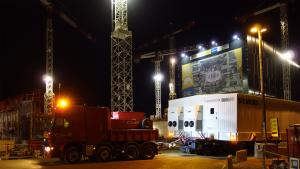Many will be heavier, none will be wider
13 Feb 2017
Of all the components that will be delivered to ITER in the years to come, many will be heavier, taller and more spectacular than the two "E-Houses" that reached the worksite shortly after 1:00 a.m. on Thursday 9 February.
The "E-house" that was installed on its final location upon arrival was the smallest of the two. Still, at 8.3 metres wide, it was no small achievement to get it through the densely packed ITER worksite © DAHER
But none will be wider: at 8.7 metres wide, the larger of the two E-houses was just 30 centimetres below the limit that the ITER Itinerary can accept...
The two "houses" had travelled together from China. Upon arrival at ITER, the larger E-house (27 metres long, 8.7 metres wide, 130 tonnes) was put in storage at the entrance of the ITER site until its concrete base could be realized; its near twin (24 metres long, 8.3 metres wide, 110 tonnes) was installed in its final location between the electrical switchyard and the large transformers.
The installed E-house will be progressively equipped with the complex set of cables that will connect it through the switchyard to the French national grid.


